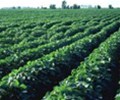

It was only last year that Brazilian farmers endured a severe six-month long drought, leading to delays in planting soybeans and sowing the second corn crop.
In 2021 too, Brazil—the world’s major soybean and corn supplier—is facing one of its most severe droughts for 90 years, according to the US Department of Agriculture, threatening a repeat of the disruption to the growing and harvesting seasons.
As a result, analysts anticipate a tight supply situation for Brazilian beans and especially corn until 2022.
The Brazilian supply woes coupled with China’s robust demand for both corn and soybeans, looks like a perfect recipe for price bullishness in coming months.
Therefore, analysts see a huge opportunity for US soybean and corn growers again in 2021 to fill in during periods of lower Brazilian exports due to the planting and harvesting delays, or pick up market share if Brazil’s crop is reduced.
Brazil and the US are the top two producers and exporters of soybean and corn and directly compete in the international agricultural market.
Soybeans resilient, corn suffers
The drought in Brazil during 2020 led to a month’s delay in soybean planting. Consequently, sowing of the second corn crop, which is planted immediately after the soybean harvest in January, was postponed too.
Typically, soybean planting in Brazil begins in mid-September, while harvesting starts in January. But the postponements last year meant the beans were planted late into October and November, while the harvest moved at a sluggish pace and was completed late into February.
Despite the delay, Brazilian soybean output in the 2020-21 marketing year (February 2021-January 2022) has remained largely unaffected. In fact, the late-planted oilseeds benefitted immensely from the January deluge. The beans output estimate was revised up to an all-time high 136 million mt, the Brazilian Ministry of Agriculture’s Supply Management Company, or CONAB, said July 8.
Brazilian soybean output is likely to sustain this momentum in MY 2021-22, reaching an unprecedented 140 million mt, S&P Global Platts Analytics said.
However, for Brazil’s second corn crop, or safrinha corn, as it is called locally, it was a completely different story.
The safrinha, which was planted with over a month’s delay in March, became extremely vulnerable to dry weather between April and June. And the farmers’ ordeal didn’t end there, as frost in July dealt a further blow to the crop’s yield.
Based on several analyst projections, the mean expectation for Brazilian second-crop corn production for MY 2020-21 now stands at less than 65 million mt, down 23% from initial estimates. The mean estimate for Brazil’s total 2020-21 corn output is 90 million mt, down 17% from early season projections.
The steady reduction in Brazilian corn estimates for MY 2020-21 since July last year has been one of the primary factors in the ongoing price rally in corn futures.
US corn futures on the Chicago Board of Trade have been trading in the range of $5.50-$6.00/bushel in July, up 75% on the year.
The surge in soybean futures prices has been remarkable as well, with a 60% year-on-year spike as the August contracts currently trade in the range of $14.10-$14.20/bushel. The soybean price rally has more to do with hefty domestic and export demand, however.
Farmers play waiting game
With Brazil caught in another year of drought, soybean and corn farmers are staring at yet another cycle of delayed planting and harvesting this year.
According to Brazil’s National Meteorological System (SNM), the current year’s drought between June and September is likely to diminish soil moisture conditions, it said. Although the drought will impact whole of Brazil, its severity will be primarily focused on the five southern states—Minas Gerais, Goias, Mato Grosso do Sul, Parana and Sao Paulo, it said.
For soybean planting, an optimum level of soil moisture is needed, coupled with favorable temperature range.
According to several meteorologists, there is a very high possibility of the re-emergence of La Nina, a weather phenomenon which brings droughts in Brazil—especially in south-central Brazil, the country’s top soybean and corn producing region.
La Nina will potentially emerge between September-November in South America and could last through January, the National Oceanic and Atmospheric Administration, or NOAA, said.
The current year’s record drought in Brazil, coupled with La Nina during the soybean planting season, is most likely to defer the soybean and second corn planting. Soy farmers are likely to try to wait out the drought, hoping for wet weather late into October to begin the field activities, as they did last year.
The problems with dryness are not limited to Brazil either, with the US Midwest and Argentina also affected.
“We still have a lot of time and potential for the situation to worsen in the US as we progress through the summer with more rain needed for spring crops,” financial services provider Rabobank said.
Delayed soybean planting in Brazil, coupled with dry US Midwest means the global oilseed supply in the last quarter of this year and first half of next year remains precarious.
With China’s soybean demand forecast at an unprecedented 102 million mt in MY 2021-22, the tight oilseed supply situation is likely to sustain the current futures price rally well into the next year.
Source: Platts